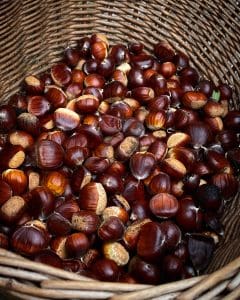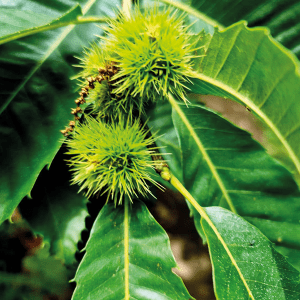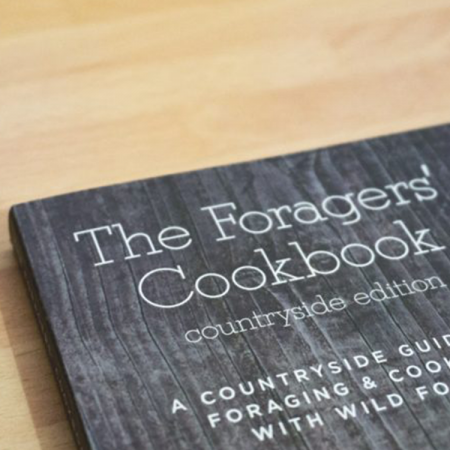This sweet chestnut puree is a great treat and can be made when the Chestnuts are at their very best, then its ready and easily at hand to add to any recipe that calls for it or used as a replacement for peanut butter. I often make this and freeze it, portioned into little bags so I can enjoy it throughout the rest of the year – not that it ever last that long as it’s so tasty!
Sweet chestnuts are a treasure of the autumn months, offering a rich, nutty flavour and a host of culinary possibilities. Their versatility and sweetness make them perfect for transforming into this delightful sweet chestnut purée.
A Brief History of Sweet Chestnuts
Sweet chestnuts (Castanea sativa) have been a staple food in many parts of the world for centuries. Native to southern Europe and Asia Minor, they were cultivated extensively by the Romans, who introduced them to other parts of their empire. Chestnuts were so important that they became known as “the bread of the poor,” especially in mountainous regions where wheat and other grains were hard to grow. These nutritious nuts provided a reliable source of carbohydrates, vitamins, and minerals.
Historically, chestnuts were used in a variety of ways: ground into flour for baking, roasted for a warming snack, or boiled to create hearty soups and stews. In the Middle Ages, chestnuts were a crucial food for many rural communities, especially during harsh winters when other crops were scarce. Today, they remain a cherished ingredient in cuisines around the world, from the marrons glacés of France to Italian castagnaccio (chestnut cake).
Identifying Sweet Chestnuts
Sweet chestnut is a large deciduous tree, reaching up to 30m when fully grown.
Identifying Features of Sweet Chestnuts:
Leaves: The leaves are about 16–28 cm long, 5–9 cm wide and oblong with a pointed tip and a toothed edge. The leaves are quite glossy.
Flowers: Long, yellow catkins.
Fruit: Shiny, red-brown fruits wrapped in a green, very spiky case.
Bark: Grey-purple and smooth, and develops vertical fissures which spiral up the tree with age.
Identify Sweet Chestnuts Full Guide Here
Sweet Chestnut Puree Recipe
This Sweet Chestnut Puree recipe is a fantastic way to capture the essence of sweet chestnuts and enjoy their creamy, nutty flavour. It’s simple to make and can be tailored to your taste preferences, making it a versatile addition to your culinary repertoire.
Ingredients:
- Peeled chestnuts (freshly roasted or vacuum-packed)
- Sweetener of your choice: sugar (white or brown), maple syrup, or pitted dates (adjust to taste)
- Whole milk or plant-based milk (such as almond or oat milk) — water can also be used, but the purée will be less creamy
- Vanilla pod or vanilla bean paste (adjust to taste)
Method:
- Prepare the Chestnuts: If using fresh chestnuts, begin by scoring their shells and roasting them in the oven until the shells peel away easily. Once peeled, they’re ready to use.
- Simmer the Ingredients: Place the peeled chestnuts in a saucepan along with your chosen sweetener, milk (or water), and vanilla. Use just enough liquid to cover the chestnuts and allow them to simmer. Cook over low heat for 20-25 minutes, or until the chestnuts are soft and the sweetener has fully dissolved. Add more liquid if needed during the simmering process.
- Strain the Mixture: Once the chestnuts are cooked, strain the mixture, reserving the excess liquid. If you used a whole vanilla pod, remove it at this stage.
- Blend to Perfection: Transfer the cooked chestnuts to a food processor and blend until smooth. Gradually add the reserved liquid to achieve your desired texture. The purée should be creamy and smooth.
- Store the Purée: Store the purée in an airtight container in the fridge for up to a week, or freeze it in small portions for up to three months. Frozen purée can be thawed as needed, making it a convenient ingredient for your kitchen.
Culinary Uses for Sweet Chestnut Purée
This versatile purée can be used in a variety of ways:
- Spread it on toast or pancakes for a luxurious breakfast.
- Stir it into yoghurt or porridge for added sweetness and richness.
- Use it as a filling for pastries, cakes, or tarts.
- Add it to soups or stews for a creamy, nutty depth of flavour.
- Blend it with cream to create a quick chestnut mousse or use it as a base for chestnut ice cream.
Extra Tips for Working with Sweet Chestnuts
- Selecting Chestnuts: Choose firm, shiny chestnuts without any signs of mould or soft spots. Fresh chestnuts should feel heavy for their size.
- Peeling: Peeling chestnuts can be time-consuming, but scoring the shells and roasting them makes the task much easier.
- Storage: Fresh chestnuts are perishable and should be stored in the fridge. Vacuum-packed or frozen chestnuts are convenient alternatives.
Making sweet chestnut purée is a delightful way to celebrate the season’s bounty while paying homage to a food that has nourished generations. Whether you enjoy it on its own, as part of a dish, or as a secret ingredient in your recipes, this purée is sure to become a favourite in your kitchen. Happy foraging and cooking!
If you want to just buy this you can of course here or search for your own








